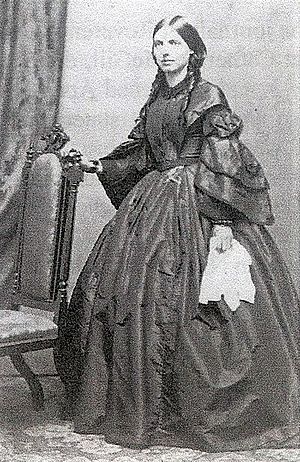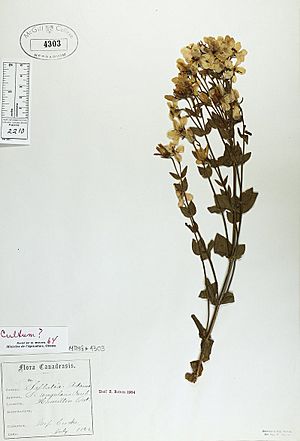Kate Crooks facts for kids
Quick facts for kids
Catharine McGill Crooks
|
|
|---|---|
 |
|
| Born | February 13, 1833 |
| Died | March 23, 1871 |
| Nationality | Canadian |
| Other names | Miss Crooks |
| Occupation | Botanist |
Catharine (Kate) McGill Crooks Smart (born February 13, 1833 – died March 23, 1871) was a talented Canadian botanist. A botanist is a scientist who studies plants. Kate was a member of the Botanical Society of Canada. She collected and pressed plant specimens, which were shown in London, England, at a big event called the 1862 International Exhibition. Her detailed notes about plants were also used in an important book, the Catalogue of Canadian Plants. This book was part of the Geological Survey of Canada, which studies the land and its natural resources. Kate came from the Crooks family, a well-known family in the 1800s in a British colony called Upper Canada.
Contents
Early Life and Family
Kate Crooks was born on February 13, 1833, in Newark, Upper Canada. Today, this place is known as Niagara-on-the-Lake, Ontario. Her father, John Crooks, was born in Scotland and moved to Canada in the early 1800s. Her mother, Mary Gumsby Lawrason, came from a family of United Empire Loyalists from New Jersey.
Kate was the youngest of five children. She had four older sisters: Margaret, Mary, Susan, and Augusta. Sadly, just a few weeks after Kate was born, her father died from scarlet fever. After this, her mother became very ill. To help their family, Kate's older sisters started a girls' school in their home.
Her Work as a Botanist
Kate Crooks joined the Botanical Society of Canada in 1861. This society was started at Queen's College, which is now Queen's University in Kingston. Kate helped create a list of plants found in Hamilton, Ontario. This list was published by her brother-in-law, Alexander Logie.
She also worked with another botanist, John Macoun, on a report about how plants change throughout the year. Kate even wrote her own paper called Remarks on the species of oak, their history, habits and uses. She presented this paper at a meeting of the Botanical Society of Canada in 1861.
Exhibitions and Recognition
Kate Crooks' collection of pressed Canadian plants was shown at the International Exhibition of 1862 in London. This was a very important event where countries displayed their best products and achievements. Kate received a special mention for her work. Her plant specimens were displayed alongside Canadian forestry, fishing, and farm products. She also showed her work at agricultural fairs in Canada, including one in Toronto.
Kate's Family Life
Kate Crooks' father, John Crooks, was important in their community. He was the postmaster in Newark and an elder at St. Andrew's Presbyterian church. He also owned a newspaper called the Niagara Herald. He started what is believed to be the first Sunday School in the Niagara region.
Kate had several interesting relatives. Her uncle, James Crooks, was a merchant and politician who fought in the War of 1812. Another uncle, Ramsay Crooks, was a Canadian fur trader. Her uncle Francis Crooks was part of a group that brought new fruit trees to the area. His daughter, Jane Crooks, was the first woman to become a member of the Niagara-on-the-Lake Public Library.
Her cousin, Adam Crooks, became a politician and lawyer. He was Ontario's Attorney General and the first Minister of Education for the province.
Marriage and Children
In July 1865, Kate married William Lynn Smart, who was a lawyer. They had three children together:
- Eleanor Herbert Mary Charlotte Smart (born October 15, 1866)
- John Alder Newton Smart (born September 11, 1868 – died November 7, 1892)
- William Catherinus Gregory Smart (born March 15, 1871 – died April 17, 1938)
Death and Lasting Impact
Kate Crooks died in Toronto on March 23, 1871. This was just eight days after her third child was born. She was buried in Hamilton, Ontario.
After Kate's death, her husband and young children faced a legal challenge from three of her sisters. They disagreed with the terms of Kate's will because she was a married woman. At that time, married women in Ontario did not have the same rights as men to own and control property.
Kate's cousin, Adam Crooks, who was a politician, helped change this. He introduced a new law called the Married Women’s Real Estate Act in 1873. This law allowed married women to own and manage their own property. It became law in Ontario on March 29, 1873, two years after Kate's death. This law was important because it gave women more control over their lives and allowed them to take part in the growing economy.
Legacy of Kate Crooks
One of Kate Crooks' pressed plant specimens is kept at the herbarium at McGill University in Montreal, Quebec. This specimen is a plant called Sabatia angularis. Kate collected it in Hamilton, Ontario, in July 1865. This is the only known time this plant was collected in Ontario, as it is now no longer found in that region. It is not known if any other plants collected by Kate Crooks still exist today.
Kate's detailed plant records have been used in many scientific books and reports. These include:
- Atlas of the Rare Vascular Plants of Ontario (1982)
- The Plants of Buffalo and Its Vicinity (1882)
- “Flora of Hamilton District” (1894)
- “Monograph of the Canadian Caryophyllaceae” (1890)
- Catalogue of Canadian Plants (1883)
- “Synopsis of the Flora of the Valley of the St. Lawrence and Great Lakes” (1876)


